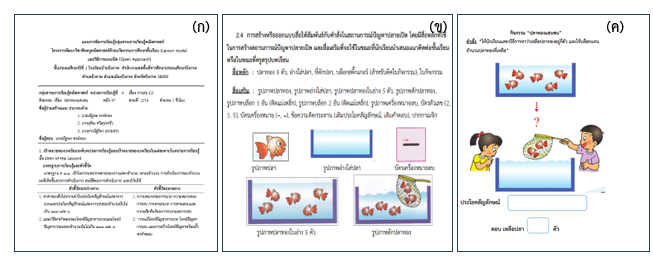ผลการจัดการเรียนรู้แบบเปิดร่วมกับแนวคิด Concrete-Pictorial-Abstract (CPA) ที่มีต่อความรู้สึกเชิงจำนวนและผลสัมฤทธิ์ทางการเรียนทางคณิตศาสตร์ เรื่อง การลบ ของนักเรียนชั้นประถมศึกษาปีที่ 1
Main Article Content
บทคัดย่อ
การวิจัยในครั้งนี้มีวัตถุประสงค์เพื่อ 1) เปรียบเทียบความรู้สึกเชิงจำนวน เรื่อง การลบ ของนักเรียนชั้นประถมศึกษาปีที่ 1 ก่อนและหลังการจัดการเรียนรู้แบบเปิดร่วมกับแนวคิด Concrete-Pictorial-Abstract (CPA) 2) เปรียบเทียบผลสัมฤทธิ์ทางการเรียนคณิตศาสตร์ เรื่อง การลบ ของนักเรียนชั้นประถมศึกษาปีที่ 1 ก่อนและหลังการจัดการเรียนรู้แบบเปิดร่วมกับแนวคิด Concrete-Pictorial-Abstract (CPA) และ 3) เพื่อศึกษาความสัมพันธ์ระหว่างความรู้สึกเชิงจำนวนกับผลสัมฤทธิ์ทางการเรียนคณิตศาสตร์ เรื่อง การลบ ของนักเรียนชั้นประถมศึกษาปีที่ 1 กลุ่มตัวอย่างที่ใช้ในการวิจัย ได้แก่ นักเรียนชั้นประถมศึกษาปีที่ 1 โรงเรียนบ้านบึงกาฬ ปีการศึกษา 2567 จำนวน 24 คน ได้มาโดยการสุ่มแบบกลุ่ม เครื่องมือที่ใช้ในการวิจัย คือ แผนการจัดการเรียนรู้ แบบทดสอบวัดความรู้สึกเชิงจำนวน แบบทดสอบวัดผลสัมฤทธิ์ทางการเรียน วิเคราะห์ข้อมูลโดยใช้สถิติพื้นฐาน สถิติทดสอบที และการหาสัมประสิทธิ์สหสัมพันธ์แบบเพียร์สัน ผลการวิจัยพบว่า 1) ความรู้สึกเชิงจำนวน เรื่อง การลบ ของนักเรียนชั้นประถมศึกษาปีที่ 1 หลังเรียนสูงกว่าก่อนเรียนอย่างมีนัยสำคัญทางสถิติที่ระดับ .01 2) ผลสัมฤทธิ์ทางการเรียนคณิตศาสตร์ เรื่อง การลบ ของนักเรียนชั้นประถมศึกษาปีที่ 1 หลังเรียนสูงกว่าก่อนเรียนอย่างมีนัยสำคัญทางสถิติที่ระดับ .01 และ 3) ความรู้สึกเชิงจำนวนมีความสัมพันธ์ทางบวกกับผลสัมฤทธิ์ทางการเรียนคณิตศาสตร์ เรื่อง การลบ ของนักเรียนชั้นประถมศึกษาปีที่ 1 อย่างมีนัยสำคัญทางสถิติที่ระดับ .01 (r = 0.946)
Article Details

อนุญาตภายใต้เงื่อนไข Creative Commons Attribution-NonCommercial-NoDerivatives 4.0 International License.
วารสารวิทยาศาสตร์และวิทยาศาสตร์ศึกษา (JSSE) เป็นผู้ถือลิสิทธิ์บทความทุกบทความที่เผยแพร่ใน JSSE นี้ ทั้งนี้ ผู้เขียนจะต้องส่งแบบโอนลิขสิทธิ์บทความฉบับที่มีรายมือชื่อของผู้เขียนหลักหรือผู้ที่ได้รับมอบอำนาจแทนผู้เขียนทุกนให้กับ JSSE ก่อนที่บทความจะมีการเผยแพร่ผ่านเว็บไซต์ของวารสาร
แบบโอนลิขสิทธิ์บทความ (Copyright Transfer Form)
ทางวารสาร JSSE ได้กำหนดให้มีการกรอกแบบโอนลิขสิทธิ์บทความให้ครบถ้วนและส่งมายังกองบรรณาธิการในข้อมูลเสริม (supplementary data) พร้อมกับนิพนธ์ต้นฉบับ (manuscript) ที่ส่งมาขอรับการตีพิมพ์ ทั้งนี้ ผู้เขียนหลัก (corresponding authors) หรือผู้รับมอบอำนาจ (ในฐานะตัวแทนของผู้เขียนทุกคน) สามารถดำเนินการโอนลิขสิทธิ์บทความแทนผู้เขียนทั้งหมดได้ ซึ่งสามารถอัพโหลดไฟล์บทความต้นฉบับ (Manuscript) และไฟล์แบบโอนลิขสิทธิ์บทความ (Copyright Transfer Form) ในเมนู “Upload Submission” ดังนี้
1. อัพโหลดไฟล์บทความต้นฉบับ (Manuscript) ในเมนูย่อย Article Component > Article Text
2. อัพโหลดไฟล์แบบโอนลิขสิทธิ์บทความ (Copyright Transfer Form) ในเมนูย่อย Article Component > Other
ดาวน์โหลด ไฟล์แบบโอนลิขสิทธิ์บทความ (Copyright Transfer Form)
เอกสารอ้างอิง
Bowornsak, L., Suriyon, A. and Srikhao, S. (2023). Development of Students’ Mathematical Reasoning Ability for 8th Grade Students in Classroom using Innovation of Lesson Study and Open Approach (in Thai). Journal of Yala Rajabhat University, 18(3), 54-63
Carbonneau, K. J., Marley, S. C. and Selig, J. P. (2013). A meta-analysis of the efficacy of teaching mathematics with concrete manipulatives. Journal of Educational Psychology, 105(2), 380-400.
Chaiprueksathon, W., Pattanajak, A. and Inprasitha, M. (2018). Representations in flow of lesson in classroom using lesson study and open approach. In Proceedings of The 19st National Graduate Research Conference (pp. 1060-1069). Khon Kaen: Faculty of Education, Khon Kaen University.
Edmonds, W.A. and Kennedy, T.D. (2017). An applied guide to research designs quantitative qualitative and mixed methods (2nd edition). Los Angeles SAGE Publications Ltd.
Hongthong, N., Samnakbankhok, H. and Akkharanit, V. (2024). Mathematical Understanding on Division of Grade 4 Student in Classroom Using Innovation of Lesson Study and Open Approach (in Thai). Journal of Computer and Creative Technology, 2(1), 6–16.
Hongthong, N., Sangsrikaew, P. and Pimpasalee, W. (2024). Development Of Critical Thinking Skill And Mathematical Achievement On Quadratic Function Of Grade 9 Students Using Open Approach And Geogebra (in Thai). Journal of Education and Innovation, 26(2), 106–117.
Inma, S. and Poonpaiboonpipat, W. (2021). The development of mathematical visualization abilities through learning implementation based on concrete pictorial abstract: CPA approach with stick and ball geometry kit on three-dimensional geometry of grade 6 students (in Thai). Journal of Industrial Education, 20(2), 22-32.
Inprasitha, M. (2022), Lesson study and open approach development in Thailand: a longitudinal study, International Journal for Lesson and Learning Studies, 11(5), 1-15.
Jordan, N. C., Glutting, J. and Ramineni, C. (2010). The importance of number sense to mathematics achievement in first and third grades. Learning and individual differences, 20(2), 82-88.
Jordan, N. C., Kaplan, D., Ramineni, C., and Locuniak, M. N. (2009). Early math matters: kindergarten number competence and later mathematics outcomes. Developmental psychology, 45(3), 850.
Kalyason, M., Khechornphak, T. and Juntachum, N. (2022). development of mathematics learning achievement using the open approach of the grade 3 students (in Thai). Srinakharinwirot Academic Journal of Education, 23(1), 19–36.
Kirkland, P. K., Guang, C., Cheng, Y. and McNeil, N. M. (2024). Mature number sense predicts middle school students’ mathematics achievement. Journal of Educational Psychology.
Kunjanthuek, P., Ugsonkid, S., Chuntra, C. and Tangkawsakul, S. (2023). The Study of Mathematical Problem-Solving Ability on Conic Section of Mathayomsuksa Four Students onConcrete-Pictorial-Abstract (CPA) (in Thai). Journal of Legal Entity Management and Local Innovation, 9(7), 232-243.
Lokkathat, T., Phukrongtung, S. and Kanngandee, P., (2023). The Development of Mathematical Concepts on The Decimal of Prathomsuksa 5 Students Using Cpa (Concrete-Pictorial-Abstract) Approach (in Thai). In Proceeding of the 3rd kamphaeng phet rajabhat university Student national Conference (pp 370-380). kamphaeng phet: kamphaeng phet rajabhat university.
Mekkhala, P., Jermtaisong, R. and Lhongsap, P. (2023). The Development of Mathematics Conceptual Through the Concrete-Pictorial-Abstract (CPA) Learning Management and LEGO of the Primary 4 (Grade 4) Students (in Thai). Journal of Education, Prince of Songkla University Pattani Campus, 34(3), 212–225.
Ministry of Education. (2017). Indicators and Core Content Mathematics Department (Revised Version B.E. 2560, A.D.2017) The Basic Education Care Curriculum B.E. 2551 (A.D. 2008). (in Thai). The Agricultural Cooperative Federation of Thailand Limited.
National Council of Teachers of Mathematics (1989). Curriculum and evaluation standards for school mathematics. NCTM.
Nohda, N. (2000). Teaching by open-approach method in Japanese mathematics classroom. In Proceedings 24th of the Conference of the International Group for the Psychology of Mathematics Education (pp 39-53).
Onnanai, P., Sangsrikaew, P. and Pimpasalee, W. (2023). The Development of Mathematics learning achievement on Linear Equations with One Variable for Grade 7 Students by Using Concrete Pictorial Abstract (CPA) together with the Bar Model (in Thai). In Proceeding of the 3rd kamphaeng phet rajabhat university Student national Conference (pp 332-341). kamphaeng phet: kamphaeng phet rajabhat university.
Pawattana, A., Chusorn, P., Nillapun, S., Prasarnphanich, S., Kanhapong, A. and Chanthes, P. (2021). The Study of Creative Problem Solving for Grade 2 students on the title the number greater than 1000 by using Open Approach and Lesson Study (in Thai). Neu Academic and Research Journal, 11(3), 301–316.
Thammawiwat, N., Sangaroon, K. and Thinwiangthong, S. (2024). Students’ Creative Problem Solving in Mathematics Classroom Using Lesson Study and Open Approach (in Thai). Mahachula Academic Journal, 11(1), 148-162.
The Institute for the Promotion of Teaching Science and Technology. (2017). A guide to using the curriculum to learn mathematics (revised version B.E.2017) according to the core curriculum for basic education, 2008 (in Thai). Retrieved 30 August 2024, from SciMath: https://www.scimath.org/ebook-mathematics/item/8380-2560-2551-8380.
Vannakovida, P., Changsri, N. and Inprasitha, M. (2024). Students’ Number Sense in Classroom Using Lesson Study and Open Approach. In Proceedings of The 21st National Graduate Research Conference (pp. 1-8). Khon Kaen: Faculty of Education, Khon Kaen University.
Wadeesirisak, T. and Pattanjak, A. (2022). An analysis of student’s mathematical understanding through flow of lesson in open-ended problem solving (in Thai). Journal of MCU Social Science Review, 11(6), 140-154.


